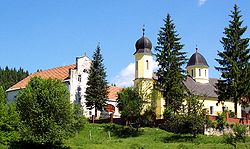
Eastern Orthodoxy in Croatia refers to adherents, religious communities, institutions and organizations of Eastern Orthodox Christianity in Croatia. It is the second-largest religious denomination in Croatia, behind the Roman Catholic Church. Over 128 000 people, forming 3.32% of the total Croatian population, are Eastern Orthodox Christians (2021).
Contents
Eastern Orthodoxy in Croatia is represented foremost by the Serbian Orthodox Church, which claims most of the Eastern Orthodox Christian faithful. Other major jurisdictions are the Bulgarian Orthodox and Macedonian Orthodox Churches. These three churches are recognized by the state. [1] [2] In Croatia there are also adherents to the Montenegrin Orthodox Church. In the past, there was a Croatian Orthodox Church, although it was unrecognized by the Serbian Orthodox Church.









